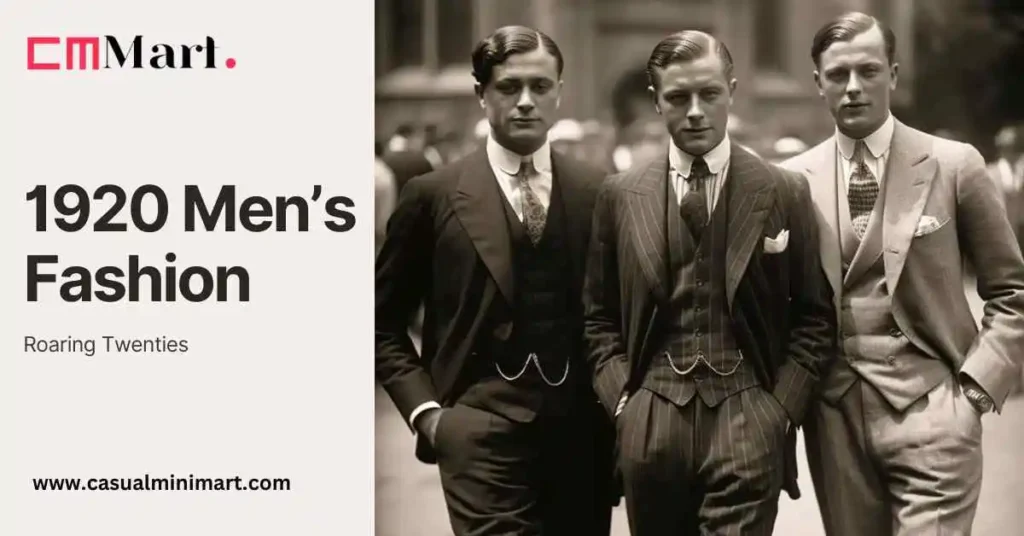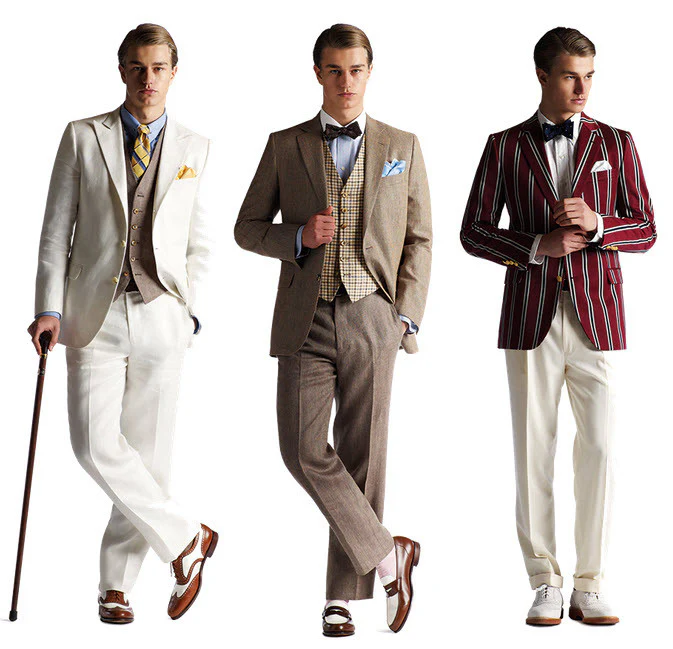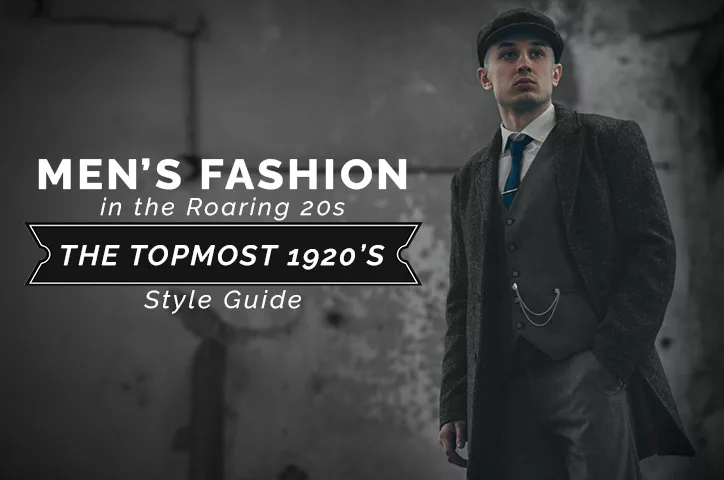1920s men’s fashion blended sharp tailoring, bold patterns, and luxurious details, reflecting an era of elegance, rebellion, and newfound freedom.
Men’s fashion during the 1920s, often referred to as the “Roaring Twenties,” was a remarkable representation of the intensity and innovation of this intensely innovative decade. Following World War I, society was recharging, and design played a significant role in bringing this underutilized sense of modernity and opportunity to the fore. The 1920s saw a dramatic shift in menswear from the seriousness of the previous decade, with more daring and free-spirited looks becoming increasingly popular. Refinement, tastefulness, and a dash of rebellion characterized the 1920s men’s fashion, which ranged from the smart suits of the upper class to the baggy casualwear of the masses.
The Rise of the Suit: The Pinnacle of Masculine Style

The introduction of slimmer, more tailored silhouettes in the 1920s made the classic suit the focal point of men’s fashion. The “drape suit,” with its gentler, flowing lines and less rigid structure, replaced the traditional, boxy suits of the previous century. Typically constructed from fleece, tweed, and silk, these suits were designed to accentuate the wearer’s physical features without sacrificing comfort.
The 1920s suit coat was characterized by a longer length, narrower lapels, and a three-piece design with a vest. All too often, high-waisted pants were worn, and creases became a common feature. The color scheme ranged from subdued hues like navy and dark to bolder, lighter tones like beige, tan, and light dark, interspersed with sporadic check or stripes.
The Shirt and Tie: Expressing Individuality
An equally critical perspective of a man’s closet in the 1920s was provided by the shirt worn underneath the suit coat. Despite the fact that men often wore designed shirts in light pastel colors with subtle stripes or checks, the most popular option was pressed, white dress shirts. The collars were sturdy, sometimes showing off detachable tips, and could be accessorized with a variety of ties. Wide stripes, paisleys, or geometric patterns were popular choices during this time, and ties were typically vibrant and strong. Bow ties were also popular, especially among people in the arts or higher social classes.

The Gatsby Influence: Hollywood Glamour Meets Street Style
Due in large part to the influence of Hollywood, design icons, and social icons like F, the 1920s saw a significant shift in men’s fashion. This is The Extraordinary Gatsby by Scott Fitzgerald. Rich, self-assured, and impeccably attired, Jay Gatsby personified the idealized man of the 1920s. With its opulent embellishments and rich textures, Gatsby’s design aesthetic created a “flashy elegance” that became incredibly alluring to the upper class of Americans. This style combined the smart, albeit slightly rebellious, attitude of the masses with the formal tastefulness of the tip top.
Clothing became more opulent for men in higher social classes, with opulent materials like velvet and silk being reserved for formal events. The Jazz Age’s design influence was less about wealth and more about the average person.
The Hat: An Essential Accessory
In the 1920s, a stylish hat completed any ensemble. Fedoras, bowler hats, and trilby hats were the most worn hat styles. The fedora, a representation of sophistication and style, was usually worn during the day with a suit, while the bowler hat, with its rounded crown, was a little more formal and conservative. On informal occasions, men usually opt for a straw boater hat or cap.
Casual Wear: A Break from Formality

Although formal wear dominated the elite’s fashion scene, casual clothing also gained popularity during the 1920s. This was particularly true in more laid-back settings with a strong emphasis on leisure pursuits, such as country clubs, golf courses, and beaches. Men wore lighter materials in more casual styles, such as linen, cotton, and seersucker, when engaging in leisure activities.
The “summer suit,” a white or cream-colored linen outfit perfect for warm-weather recreational activities, was the men’s fashion choice in the 1920s. Men wore knee-length pants called knickerbockers, golf sweaters, and sometimes a blazer with a cap for more informal events, particularly outside.
Footwear: Sophistication at Your Feet
The dapper look included a lot of shoes from the 1920s. https://thedarkknot.com/blogs/suitupdressup/1920s-mens-fashion-guide-timeless-style?srsltid=AfmBOoo8J4orgr6U0S4jiApv_lDEjnZrRl4fymoC0z2HFcSSJFMDdvHBThe most fashionable footwear during the Jazz Age was Oxfords and brogues, which were frequently colored in two tones. These shoes featured elaborate stitching or character-enhancing perforations, and they were constructed of premium leather. Men could wear loafers or even slippers for a more casual or lively look, but cleaned calfskin shoes in dark or brown were the standard choice for night wear or more formal occasions.
The Bold Accessories: Adding the Finishing Touches
Accessory pieces played a major role in 1920s fashion, giving men a platform to showcase their uniqueness. Men’s outfits became incomplete without long-chain watches, cufflinks, tie pins, pocket squares, and other accessories, and they often paid attention to these small details to finish the look. In particular, the handkerchief was a sophisticated item that was often used to inject some color or flair into the otherwise subdued suit.
The Legacy of 1920s Men’s Fashion
The 1920s design movement has an influence on men’s fashion today. These days, it really makes a statement with its emphasis on extravagance, unique articulation, and excellent fitting. This era is responsible for the emphasis on fine tailoring, the rise of casualwear in men’s wardrobes, and the slim silhouette. In a world changing quickly, men used the 1920s fashion to express their newly found sense of modernity and independence. It was more than just clothes.
The 1920s laid the groundwork for today’s sophisticated and well-groomed men, marking a truly transformative decade for men’s fashion. The refined suits of the wealthy elite and the casual clothes of common laborers alike are examples of the Jazz Age’s design, which remains a timeless symbol of elegance and style.
Conclusion
In conclusion, men’s fashion from the 1920s captures the essence of the Roaring Twenties, a time of radical change from the past as well as a time of emancipation and cultural excitement. This decade revolutionized menswear by fusing sophistication with individuality, as seen in the rise of casual sophistication, bold accessories, and fitted suits. Affected by the post-war yearning for opportunity and social change, men adopted style as a means of expressing themselves on everything from the streets to jazz clubs. The 1920s aesthetic endures today as a classic representation of refinement, assurance, and the craft of personal style.



